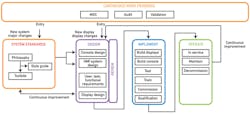It’s been a long haul since the ISA101 committee was first formed in 2006, but it looks like a new standard on human-machine interfaces (HMIs) will finally be issued before the year is out. It’s not uncommon for standards to take many years to develop. But this is a set of standards that a lot of people in the industry are very eager to get their hands on.
“We’ve had our ups and downs, but industry is really waiting for this,” says Maurice Wilkins, vice president of Yokogawa’s Global Strategic Marketing Center and co-chair of the ISA101 committee.
The standard was approved this past June based on the ballot presented at the ISA Spring Leaders Meeting in Raleigh, N.C. “That being the case, we have to go back and address all the comments,” Wilkins says, explaining that there will then be one more round to go. A final, shorter ballot will be presented at that point, and people will have the opportunity to change their votes.
The committee does not expect to see extensive changes from the first ballot. The final standard should be issued some time in the fourth quarter this year.
One issue that has come to the fore in more recent years, however, and that the committee needs to address, is mobility—a topic that was hardly on the radar when the committee first formed eight years ago. “The standard was started before the iPhone was even developed,” Wilkins notes.
Which brings up a point about technical standards in general, and the years they take to develop. The technology can change considerably along the way, making the work a bit like herding cats. “We’re really racing against time these days,” Wilkins says.
Standards development must work against the usual drifting of people in and out of the scene, changing jobs and whatnot. Not to mention throwing a sizable recession into the midst, in this case.
But HMI is also a fairly emotional topic, Wilkins says, and people have different ideas of how it should work. The first draft, issued for review in June 2010, received 699 comments. The committee has since issued four more drafts and one requirements survey, and has received 3,786 comments in all.
So yes, people have opinions about HMI. Some will say that red means alarm or stop, and green means go. While others will argue that their industry has different uses for those colors. For that reason, Wilkins says, the ISA101 standards will not edict exact colors or other criteria about exactly how an HMI should look.
“Instead, it says things like: The background shouldn’t contrast with the foreground so much that it gives the operator eyestrain,” Wilkins explained. “We will give examples in the technical reports as to how things should look—how to design HMI, how to put it together, the lifecycle of HMI, it will do this and not do that, here’s how a good HMI should look.”
The committee will begin work on the technical reports Wilkins mentions once the standard is issued. Topics will include HMI Philosophy Development, HMI Style Guide Development, HMI Design Guide Development, HMI Usability and Performance, HMI Purchase Specification, and Design Considerations for Mobile HMIs.
“We’ve already got people lining up from multiple teams to work on the technical reports,” Wilkins says. He expects those to take no more than a year, which is an accelerated schedule.
To learn more about the winding road to ISA101, read “ISA101 HMI Standard Nears Completion,” written by Wilkins and committee co-chair Greg Lehmann, technical manager of the process automation department at URS, Oil & Gas Division.
About the Author
Aaron Hand
Editor-in-Chief, ProFood World

Leaders relevant to this article:
